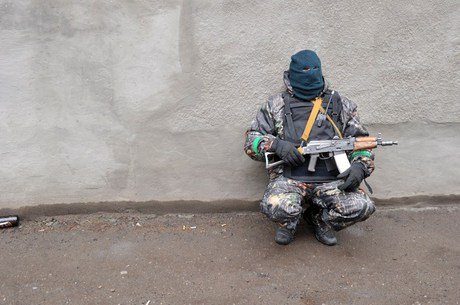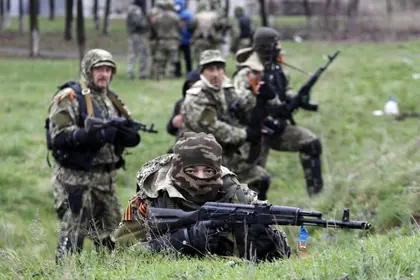“We have all concrete proof of Russia’s secret agency involvement in the separatist insurgency and takeovers of government buildings in eastern Ukraine. The evidence and witness testimonies will be presented to the international community on April 17 in Geneva,” Ukraine’s Foreign Ministry said in a statement on April 13.
Former Vladimir Putin’s adviser Andrei Illarionov, expressed a similar conviction to Ukraine’s Gordon.ua news website.
JOIN US ON TELEGRAM
Follow our coverage of the war on the @Kyivpost_official.
“I have to stress, this is an intervention, an insurgency of Russian special forces, not a separatist riot on the territory of Ukraine. If the problem is not solved within three days, the territories of Ukraine will be lost,” said Illarionov.
Some of Ukraine’s security specialists say that the Russian military operation is supported by genuine separatist sentiment in the east.
“It’s not a clean insurgence. There are, unfortunately, also separatist moods, and people think Kyiv is full of ‘Banderites’ and set them up,” says one senior source from a security agency, who spoke on the condition of anonymity because of sensitivity of the issue. “Banderites” refers to supporters of Ukrainian nationalist Stepan Bandera (1909-1959), who is reviled by the Kremlin as a Nazi collaborator.
“If it was just clearly Russian invasion, the operation would be much cleaner,” the source said.
Nevertheless, there is plenty of evidence to point to heavy Russian military presence in the coordinated takeovers.

Use of Russian weapons, well-trained men
Some of the weapons used by the “little green men,” the camouflaged soldiers with no insignia who appeared over the weekend in many towns in eastern Ukraine, are not carried by either the Ukrainian army, or any of its special agencies. In particular, automatic rifles of AK-100 series that are visible on many photos and videos from Sloviansk, are one type of such weapons.
Acting President Olekandr Turchynov also said in his April 13 address that it was “terrorist groups coordinated by the Russian Federation” who took over Interior Ministry departments and other administraive buildings in Sloviansk and other cities of Donetsk Oblast. “It was particularly dangerous in the town of Slovansk, where professionally trained criminals were working, dressed in Russian camouflage and armed with Russian automatic weapons,” Turchynov said.
Videos taken in Kramatorsk show what is clearly a well-organized military operation, where part of the camouflaged men walk inside the building, while others secure the perimeter outside as they kneel in front of the entrance, pointing their guns outwards. (More videos here and here.)

Heavy presence of Russian coordinators
Earlier this month, Ukraine’s Security Service detained Roman Bannykh, affiliated with Russia’s Main Intelligence Department, in Luhansk Oblast, when he attempted to enter Ukraine. The SBU said he organized and coordinated the work of a subversive group operating in Ukraine. SBU has reported a number of similar cases in the past two months, indicating a growth in the presence of Russia’s secret agents in Ukraine.
Dmytro Tymchuk, a retired high-ranking army officer who organizes Information Resistance, a group that fact-checks and collects military information, said that “the general supervision over the actions of separatists is performed by the coordinators of Russian Main Intelligence Department.” He also said some of the operations are performed by troops of the Main Intelligence Department of the Military Headquarters of the Russian Federation, in coordination with private guard of a Ukrainian oligarch and local separatist troops made up of volunteers.
Communication traffic traced back to Russia
The analysis of communication traffic of the separatists can be traced back to Russia. The actions of separatist forces are coordinated through radio channels and online channels, and coordinators of actions can be traced back to the Russian Federation, Ukraine security source said.

Geography of attacks is not accidental
The geography of attacks in Donetsk Oblast is not accidental for two reasons. Many of the cities that were attacked are located close to the Svyatohorsk Assumption Lavra, or monastery, of the Moscow Patriarchate, which Ukrainian security officials believe serves as a military base for the insurgents. The towns such as Sloviansk and Kramatorsk in Donetsk Oblast, where separatist actions have been particularly fierce, are easily accessible from that location.
Moreover, the towns have a certain strategic significance, particularly from the point of view of securing control over transport and access to Donetsk Oblast. Krasnoarmeisk, for example, hosts a military air base used by a flight club at the moment. Druzhkovka and Gorlovka are railway junctions.
“From the map you can clearly see that all the towns that became epicenters of conflicts (on April 12) form a provisional chain that cuts Donetsk Oblast from Dnipropetrovsk,” Levyi Bereg news website wrote on April 12.
Copy of Maidan
The separatists in eastern Ukraine attempt to copy the EuroMaidan Revolution’s successful tactics in their work. They create barricades around buildings they take over, they use car tires and set them on fire to protect themselves from attacks of anti-terrorist troops unleashed by the central government. These are all planned attempts to legitimize the separatist moves in eastern Ukraine, some analysts have noted.
At the same time, much of what happens in Ukraine is similar to the early stages of operations in Crimea. There, similarly clad military men also appeared at the early stages of the takeover of the peninsula, and were then followed by Russian army vehicles.
Turchynov, in his April 13 address, noted this similarity. “We will not allow Russia to repeat the Crimean spenario in the eastern region of Ukraine,” he said, announcing a massive anti-terrorist operation.
The action looks coordinated to be over by April 17
Ukraine’s authorities fear that the separatist actions that started in eastern Ukraine this weekend look coordinated to finish by April 17, when multilateral talks are planned on Ukraine-Russan relations in the wake of Crimea annexation.
But Russia’s Foreign Minister Sergei Lavrov warned U.S. State Secretary John Kerry in a telephone conversation on April 12 that the talks will not happen in Kyiv uses force to deal with insurgence in the country’s east.
“Lavrov warned that in the case of materialization of the threats that sound from Kyiv to use force against the desperate residents of southeast, the prospect of further cooperation on Ukrainian issue will be disrupted, including the planned four-side meeting in Geneva” Russia’s Foreign Ministry warned in its April 13 statement.
Kyiv Post deputy chief editor Katya Gorchinskaya can be reached katya.gorchinskaya@gmail.com
You can also highlight the text and press Ctrl + Enter




